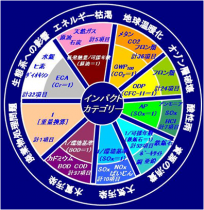Development of environmental impact evaluation methods by the comprehensive ELP (Environmental Load Point) index

- researcher's name
-
about researcher NAGATA, Katsuya Professor (retired)
- affiliation
- keyword
-
background
With growing interest in the ever-worsening problems of global warming and energy, efforts to reduce the environmental load are being implemented in a variety of fields. Causative factors of environmental load include the sectors of industry, transport and civilian life, but there have been no proactive efforts concerning the latter of these, which incorporates our everyday lives, compared to the other sectors, and it remains unclear as to what extent improving our actions in everyday life is contributing to decreasing the environmental load.
summary
ELP (Environmental Load Point) is an integrated index in LCA (Life Cycle Assessment), which was developed in these research seeds.
The nine problems, “energy drain”, “global warming”, “ozone depletion”, “acid precipitate”, “resource consumption”, “air pollution”, “ocean & water pollution”, “waste disposal problems” and “ecosystem effect” have been categorized into environmental impact areas and categories have been prioritized based on questionnaire surveys conducted by the panel. Using the category priorities as coefficients, an integrated index was developed to enable the assessment of environmental loads in different sectors using standardized units.
application/development
Conducting LCA with the use of ELP makes it possible to easily carry out quantitative assessment of efforts in the field of civilian life, which has traditionally been difficult, and can serve as a guide for encouraging proactive environmental load reduction in the civilian sector. Developing LCA further makes LSA (Life Style Assessment), which comprehensively evaluates the environmental load of our actions based on lifestyle and the products used in these actions, possible as a wide-ranging assessment.
predominance
In addition to the ability to conduct relative evaluation of the actual effects on reducing environmental load, of various kinds of environmental consideration actions, even those from different categories, it allows consistent evaluation of not only the life cycle of a product, but also from the stage of resource investment to disposal; this is something other assessment methods do not provide.
purpose of providing seeds
Sponsord research, Collaboration research
material
posted:
2014/05/21




